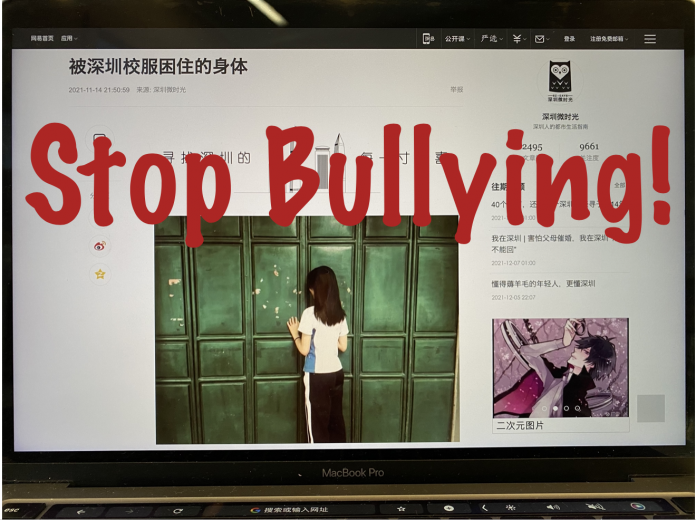Body type is becoming the only concern for students trapped in social media platforms.
By Jack Deng
Middle school student Lily Xie experienced bullying and body shaming in 2020 due to her body shape for one year. The girl is no longer suffering from bullying now because her parents noticed this and got involved.
Xie says slim girls tailor their school uniform to make themselves look even slimmer and they post photos on social media like WeChat or Weibo. “I wanted to do what they did so I bought a smaller size uniform, but it did not work for me,” the 14-year-old girl says.
Xie’s classmates gave her a nickname – “fat pig”. “Boys poked my waist with their pens. It really hurt. I was afraid and embarrassed, so I just smiled and quickly walked away,” the eighth-grade girl says.
“Boys talk about girls’ pictures and leave comments to praise their body shape. But if I post my photos online, I will be a subject of ridicule,” she says.
Xie spends at least 20 hours per week on social media platforms to browse pictures of slim girls and clips about losing weight by bloggers.

Journal of the American Medical Association (JAMA), a monthly peer-reviewed medical journal, published a study in July 2019 which mentioned the level of adolescents’ social media usage is a significant predictor of their depression levels. For every additional hour of social media use, depressive symptoms of teens will increase by two per cent.
According to Xie, she was once depressed but finally cured due to the help of her parents.
Xie points out: “I want to be slimmer. I want to post my selfies and have many likes as well…just like other girls who have a slender body shape. I want people to stop calling me ‘pig’.”
Xie is not alone, not only Chinese students face this dilemma. Research conducted by tech writer Paul Bischoff in 2019 surveyed more than 1,000 parents in America and asked them about whether their children had experienced cyberbullying. Around 60 per cent of them said yes.
Shen Yuefei, who has worked in a middle school in Shenzhen for over 10 years, has observed a similar trend in China.
“It is worrying to see that teenagers care about their appearance rather than their study. I find that more students nowadays suffer from bullying and depression because of their body figure,” she points out.

(Photo Courtesy of Lily Xie)
According to a journal article issued on The Clinical Psychological Science in November 2017, compared with adolescents who spend only one hour per day, those who spend more than five hours per day on social media have a 66 per cent increased risk of suicide-related outcomes.
In March 2021, a 15-year-old student from Shen’s school attempted suicide after suffering from cyberbullying and body shaming for more than one year.
Shen recalls: “That girl has a big red birthmark on her right cheek. Other students called her ‘dinosaur’ instead of her real name. They discussed her appearance in group chats.”
“The girl had planned to jump from the second floor of the school building after a boy made fun of her look on WeChat. He posted her photo with insulting marks on her face in a group chat. The student was subsequently transferred to a private school,” she continues.
Shen reveals the school management offered RMB ¥150,000 to her parents and asked them not to speak to the media or report to the education bureau.
Shen’s school set up a unit to handle students’ mental issues after the incident in September 2012.
“But I have never seen anyone seeking help from the unit. Schools nowadays are trying to deal with these issues in a low-key manner,” says Shen.
Cheng Qijin, assistant professor from the social work faculty of the Chinese University of Hong Kong, believes that social media is one of the factors that affect teenagers’ mental health.
“The young generations are ‘net natives’. But their mental development is not ready to handle the cyberworld,” says Cheng.
She points out children will lack empathy, as they do not see or feel the pain of others after they have hurt someone online.
“The young generations are ‘net natives’. But their mental development is not ready to handle the cyberworld.”
“Social media platform has the responsibility to protect teenagers from harmful information like bullying or violence,” Cheng says, “They should change their profit-driven algorithms but surely the cost will be high to the social media companies.”
The social work professor who focuses her study on mental health promotion and media studies points out that strengthening media literacy education is necessary.
Cheng suggests parents give more attention to their children’s mood swings when they are using social media platforms.
“Cutting electronic devices off from children will not be a smart choice especially when teenagers are in their rebellious stages,” Cheng says.
“Parents should guide and keep their children accompanied when they are using social media. Schools should introduce guidelines on surfing on the internet in their curriculum,” she says.
“Schools should introduce guidelines on surfing on the internet in their curriculum.”
Edited by Vivian Cao
Sub-edited by Soweon Park







































